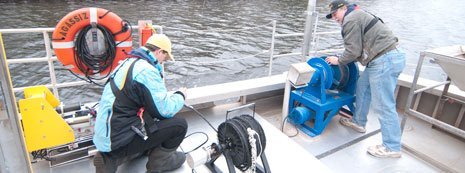Title
Laboratory study of gypsum dissolution rates for an abandoned underground mine
Document Type
Article
Publication Date
1-2-2019
Abstract
Groundwater reestablishment in abandoned gypsum mines causes pillar dissolution until the groundwater reaches the groundwater’s gypsum saturation potential. In some cases, however, especially in shallow mines, groundwater can continue to flow through the mine resulting in the additional dissolution of the mine’s support pillars leading to possible pillar collapse. Pillar dissolution will depend on the amount and quality of the groundwater flowing through the mine and the dissolution rate of the gypsum. The Domtar Mine in Grand Rapids Michigan operated for over 140 years mining a 30-m-deep high-quality gypsum deposit. In 2000, the mine was abandoned with the removal of the mine’s dewatering pumps allowing the groundwater to flood the mine. The mine is located along the north side of the Grand River and has groundwater flowing through the mine to the Grand River. Interstate I-196 is located over the east side of the mine. To analyze the stability of the mine’s pillars, the gypsum dissolution rate was investigated. In this research, laboratory experiments were conducted to investigate the dissolution rate of natural gypsum in both stagnant and flowing water. The existing published dissolution rates were reviewed and compared to the investigation’s results. The tests confirmed that the dissolution can be represented by a first-order kinetic equation. The normalized dissolution coefficient was measured for stagnant water at 1.6 × 10−3 (cm/s) following the power law of k = 0.0021F0.1854 for flowing water, where F is the water’s flow rate and k is dissolution coefficient.
Publication Title
Rock Mechanics and Rock Engineering
Recommended Citation
Sadeghiamirshahidi, M.,
&
Vitton, S.
(2019).
Laboratory study of gypsum dissolution rates for an abandoned underground mine.
Rock Mechanics and Rock Engineering.
http://doi.org/10.1007/s00603-018-1696-6
Retrieved from: https://digitalcommons.mtu.edu/cee-fp/61


Publisher's Statement
© Springer-Verlag GmbH Austria, part of Springer Nature 2019. Publisher's version of record: https://doi.org/10.1007/s00603-018-1696-6